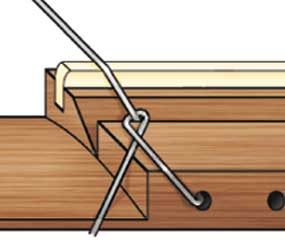
Guitar Preparation
Strings

It is important to have the correct set of strings fitted to your guitar, especially if you are a beginner. Until you build enough strength in your hands to fret the chords cleanly, light gauge or low tension strings are recommended. A reputable music store which sells guitar strings should be able to assist with this. Do not put steel strings on a classical guitar or it will damage the neck of the guitar. It is important to change your strings regularly, as old strings are more difficult to keep in tune.
Fitting the Strings
Strings must be correctly fitted to the guitar otherwise you will encounter tuning problems. In the early stages of learning the guitar it is recommended that you get a qualified guitar repairer or an experienced guitar player to fit the strings to your guitar.
Tying the string to the bridge: There are basically two methods to tying the string to the bridge. Study the following diagrams. With both types of knot shown it is important to finish the knot behind the back of the bridge. This will reduce the possibility of the string slipping.
Option 1.



Option 2.




Tying the string to the tuning key: It is important to have a short length of the string protruding through the hole in the tuning key barrel. This part of the string can then be clamped to the barrel as the string is coiled onto the barrel (see diagram). The string should coil neatly around the barrel at least 4 -5 times.


String Height
The height of the strings from the fretboard (sometimes called the "action") is very important to the feel of the guitar. If the strings are set too high, it will be more difficult to push the strings onto the fretboard. If the strings are set too low, the strings will rattle against the fretboard causing a buzzing noise. The height of the strings is determined by two things, the nut and the bridge saddle. These adjustments should be carried out by a qualified guitar repairer.